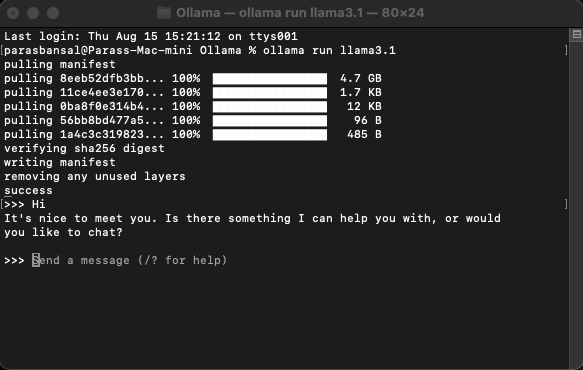Home >Web Front-end >JS Tutorial >Local GPT with Ollama and Next.js
Local GPT with Ollama and Next.js
- PHPzOriginal
- 2024-08-16 06:16:031029browse
Introduction
With today's AI advancements, it's easy to setup a generative AI model on your computer to create a chatbot.
In this article we will see how a you can setup a chatbot on your system using Ollama and Next.js
Setup Ollama
Let's start by setting up Ollama on our system. Visit ollama.com and download it for your OS. This will allow us to use ollama command in the terminal/command prompt.
Check Ollama version by using command ollama -v
Check out the list of models on Ollama library page.
Download and run a model
To download and run a model, run command ollama run
Example: ollama run llama3.1 or ollama run gemma2
You will be able to chat with the model right in the terminal.

Setup web application
Basic setup for Next.js
- Download and install latest version of Node.js
- Navigate to a desired folder and run npx create-next-app@latest to generate Next.js project.
- It will ask some questions to generate boilerplate code. For this tutorial, we will keep everything default.
- Open the newly created project in your code editor of choice. We are going to use VS Code.
Installing dependencies
There are few npm packages that needs to be installed to use the ollama.
- ai from vercel.
- ollama The Ollama JavaScript library provides the easiest way to integrate your JavaScript project with Ollama.
- ollama-ai-provider helps connect ai and ollama together.
- react-markdown Chat results will be formatted in markdown style, to parse markdown we are going to use react-markdown package.
To install these dependencies run npm i ai ollama ollama-ai-provider.
Create chat page
Under app/src there is a file named page.tsx.
Let's remove everything in it and start with the basic functional component:
src/app/page.tsx
export default function Home() {
return (
<main className="flex min-h-screen flex-col items-center justify-start p-24">
{/* Code here... */}
</main>
);
}
Let's start by importing useChat hook from ai/react and react-markdown
"use client";
import { useChat } from "ai/react";
import Markdown from "react-markdown";
Because we are using a hook, we need to convert this page to to a client component.
Tip: You can create a separate component for chat and call it in the page.tsx for limiting client component usage.
In the component get messages, input, handleInputChange and handleSubmit from useChat hook.
const { messages, input, handleInputChange, handleSubmit } = useChat();
In JSX, create an input form to get the user input in order to initiate conversation.
<form onSubmit={handleSubmit} className="w-full px-3 py-2">
<input
className="w-full px-3 py-2 border border-gray-700 bg-transparent rounded-lg text-neutral-200"
value={input}
placeholder="Ask me anything..."
onChange={handleInputChange}
/>
</form>
The good think about this is we don't need to right the handler or maintain a state for input value, the useChat hook provide it to us.
We can display the messages by looping through the messages array.
messages.map((m, i) => (<div key={i}>{m}</div>)
The styled version based on the role of the sender looks like this:
<div
className="min-h-[50vh] h-[50vh] max-h-[50vh] overflow-y-auto p-4"
>
<div className="min-h-full flex-1 flex flex-col justify-end gap-2 w-full pb-4">
{messages.length ? (
messages.map((m, i) => {
return m.role === "user" ? (
<div key={i} className="w-full flex flex-col gap-2 items-end">
<span className="px-2">You</span>
<div className="flex flex-col items-center px-4 py-2 max-w-[90%] bg-orange-700/50 rounded-lg text-neutral-200 whitespace-pre-wrap">
<Markdown>{m.content}</Markdown>
</div>
</div>
) : (
<div key={i} className="w-full flex flex-col gap-2 items-start">
<span className="px-2">AI</span>
<div className="flex flex-col max-w-[90%] px-4 py-2 bg-indigo-700/50 rounded-lg text-neutral-200 whitespace-pre-wrap">
<Markdown>{m.content}</Markdown>
</div>
</div>
);
})
) : (
<div className="text-center flex-1 flex items-center justify-center text-neutral-500 text-4xl">
<h1>Local AI Chat</h1>
</div>
)}
</div>
</div>
Let's take a look at the whole file
src/app/page.tsx
"use client";
import { useChat } from "ai/react";
import Markdown from "react-markdown";
export default function Home() {
const { messages, input, handleInputChange, handleSubmit } = useChat();
return (
);
}
With this, the frontend part is complete. Now let's handle the API.
Handling API
Let's start by creating route.ts inside app/api/chat.
Based on the Next.js naming convention, it will allow us to handle the requests on localhost:3000/api/chat endpoint.
src/app/api/chat/route.ts
import { createOllama } from "ollama-ai-provider";
import { streamText } from "ai";
const ollama = createOllama();
export async function POST(req: Request) {
const { messages } = await req.json();
const result = await streamText({
model: ollama("llama3.1"),
messages,
});
return result.toDataStreamResponse();
}
The above code is basically using the ollama and vercel ai to stream the data back as response.
- createOllama creates an instance of the ollama which will communicate with the model installed on the system.
- POST function is the route handler on the /api/chat endpoint with post method.
- The request body contains the list of all previous messages. So it's a good idea to limit it or the performance will degrade over time. In this example, the ollama function takes "llama3.1" as the model to generate the response based on the messages array.
Generative AI on your system
Run npm run dev to start the server in the development mode.
Open the browser and go to localhost:3000 to see the results.
If everything is configured properly, you will be able to talk to your very own chatbot.

You can find the source code here: https://github.com/parasbansal/ai-chat
Let me know if you have any questions in the comments, I'll try to answer those.
The above is the detailed content of Local GPT with Ollama and Next.js. For more information, please follow other related articles on the PHP Chinese website!
Related articles
See more- An in-depth analysis of the Bootstrap list group component
- Detailed explanation of JavaScript function currying
- Complete example of JS password generation and strength detection (with demo source code download)
- Angularjs integrates WeChat UI (weui)
- How to quickly switch between Traditional Chinese and Simplified Chinese with JavaScript and the trick for websites to support switching between Simplified and Traditional Chinese_javascript skills

